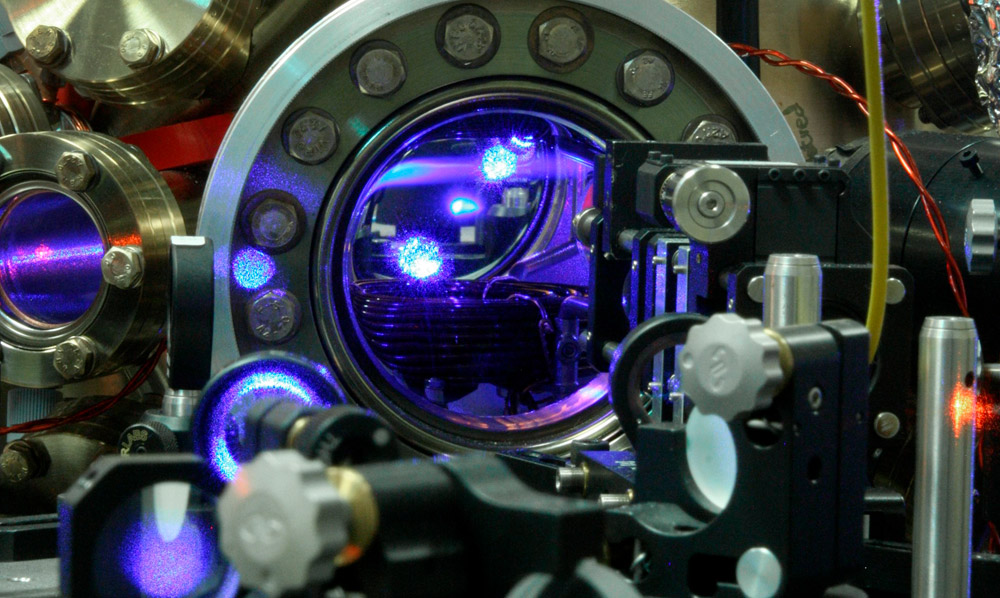There is no sign of “dark” bosons: according to some hypotheses, dark matter is composed of very light particles that can interact with electromagnetic fields. However, measurements using optical atomic clocks are now narrowing the space for such “dark” bosons. Because they could not prove any effect of these particles on three different quantum jumps in the ytterbium and strontium atoms. In doing so, the minimum mass for ultralight dark matter particles was determined.
What dark matter consists of is still one of the great mysteries of physics. After searching for heavy particles such as weakly interacting massive particles (WIMPs) came to nothing, light bosons such as axions or “dark photons” are now promising candidates. According to the hypothesis, these could interact with electromagnetic fields and also affect the quantum jumps of atoms – albeit to a very small extent.
The “dark” waves and the fine structure constant
But it is not yet clear in which mass range an extremely dark matter particle could be hiding. Although about 10 apply-22 The electron volt is the potential minimum, because the corresponding quantum physical wavelength for this particle must be the size of the entire universe. So far, however, there have been no more precise borders on the lower edge of the block.
This is where the measurement made by a team of physicists led by Melina Filzinger from the Physikalisch-Technische Bundesanstalt (PTB) comes in: if there are ultralight dark bosons, they must also influence some fundamental physical constants through their wave nature. “Their interaction with Standard Model particles should result in corresponding oscillations in fundamental constants such as the fine structure constant, electron mass, and the quantum chromodynamics mass scale,” the researchers explain.
Quantum jumps in ytterbium and strontium atoms
For their study, Filzinger and her team took a closer look at potential effects on the fine-structure constant. This affects atomic energy scales and thus also the excitation frequencies at which atoms change to a higher energy state. These quantum jumps and the exact transition frequency they require are used in optical atomic clocks to measure time. In order to measure possible fluctuations in this frequency, physicists used the ytterbium atomic clock and the strontium atomic clock as measuring instruments.
In the ytterbium atomic clock, the team measured two transition frequencies for a single ytterbium ion over a period of 235 days and 26 months. Quantum jumps were generated and measured alternately, but in the same environment and with the same particles – this made the measurements more accurate and reliable than if two different atomic clocks were used. In addition, the researchers used the measurement results of the quantum jump of the strontium atom.
No oscillations
The result: the physicists found no significant fluctuations in the frequency of quantum jumps in their measurements. So the effect of ultralight ‘dark’ bosons cannot be proven. By measuring over more than a year, very slow fluctuations can also be ruled out. Accordingly, the fine structure constant also remains constant over longer periods of time.
With this, Felsinger and her colleagues set new experimental upper bounds for the mass of the dark matter particles they are looking for and their possible coupling with the electromagnetic force. Specifically, the new bound limits the possible mass area of these particles in the range between 10-24 and 10-17 electron volts on. The high measurement accuracy also made it possible to set the detection limit by more than one order of magnitude. (Physical Review Letters, 2023; doi: 10.1103/PhysRevLett.130.253001)
Source: Physikalisch-Technische Bundesanstalt (PTB)

“Tv expert. Hardcore creator. Extreme music fan. Lifelong twitter geek. Certified travel enthusiast. Baconaholic. Pop culture nerd. Reader. Freelance student.”






More Stories
Horsehead Nebula close-up – new images from the James Webb Telescope
Reducing silent inflammation in the body with food
The science behind the “Three Body Problem” – so you can finally have your say